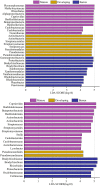Plant and Soil Development Cooperatively Shaped the Composition of the phoD-Harboring Bacterial Community along the Primary Succession in the Hailuogou Glacier Chronosequence
- PMID: 32723794
- PMCID: PMC7394357
- DOI: 10.1128/mSystems.00475-20
Plant and Soil Development Cooperatively Shaped the Composition of the phoD-Harboring Bacterial Community along the Primary Succession in the Hailuogou Glacier Chronosequence
Abstract
Microbes that produce phosphatases play an important role in the cycling of phosphorus (P), a key nutrient in soil development. We studied the development, compositional turnover, and environmental drivers of microbial communities carrying the phosphatase-encoding phoD gene (here called phoD communities) in the course of primary succession in the Hailuogou glacier chronosequence. We selected the pioneer species Populus purdomii Rehder as a model plant to study the communities in rhizosphere and bulk soils along the chronosequence. The bulk and rhizosphere soils hosted distinct phoD communities. Changes in the taxa Pseudomonas and Pleomorphomonas in the rhizosphere and Bradyrhizobium, Cupriavidus, and Pleomorphomonas in the bulk soil were associated with soil development. The plant development and soil property changes along the chronosequence were accompanied with changes in the phoD communities. Soil pH, soil organic carbon, and total nitrogen contents that are directly related to the plant development and litter input differences along the chronosequence were the main factors related to changes in community compositions. The community similarity decreased along the chronosequence, and the distance decay rate was higher in the bulk soil than in the rhizosphere. In summary, both in the rhizosphere and in bulk soils the phoD community succession was shaped by plant and soil development-related factors along the primary succession in the Hailuogou glacier chronosequence.IMPORTANCE Phosphorus was the key limiting nutrient for soil development during primary succession that occurred in alpine and high-latitude ecosystems with cold and humid climates. The interactions of functional microbiota involved in phosphorus cycling in the rhizosphere under different soil developmental stages along primary succession are still rarely examined. We selected the pioneer species Populus purdomii as a model plant to study the phoD-harboring bacterial communities in rhizosphere and bulk soils along a mountain glacier chronosequence. Our results showed that the bulk soils and rhizosphere host distinct phoD communities and diversity that differentially varied along the chronosequence, describing in detail the development and compositional turnover of the phoD community in the course of primary succession and determining the main environmental factors driving the development.
Keywords: distance decay; phoD community; primary succession; soil development.
Copyright © 2020 Bai et al.
Figures




References
-
- Jumpponen A, Brown SP, Trappe JM, Cazares E, Strommer R. 2012. Twenty years of research on fungal-plant interactions on Lyman Glacier forefront—lessons learned and questions yet unanswered. Fungal Ecol 5:430–442. doi:10.1016/j.funeco.2012.01.002. - DOI
-
- Jiang YL, Lei YB, Yang Y, Korpelainen H, Niinemets Ü, Li CY. 2018. Divergent assemblage patterns and driving forces for bacterial and fungal communities along a glacier forefield chronosequence. Soil Biol Biochem 118:207–216. doi:10.1016/j.soilbio.2017.12.019. - DOI
LinkOut - more resources
Full Text Sources
